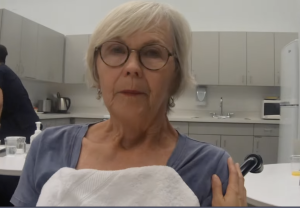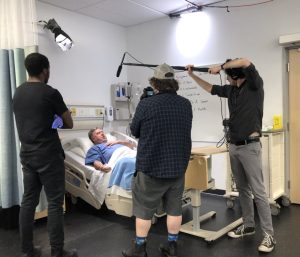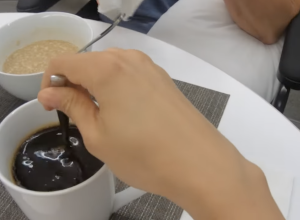Point of View in Filming
When filming your virtual gaming simulation, you can choose to film from a first-person point of view or a second-person point of view.
First-Person Point of View Filming
First-person point of view filming can create an authentic, immersive perspective for the learner when playing the virtual gaming simulation, as the learner is moving through the scenario from the healthcare provider’s point of view. This perspective can enhance learning of how to communicate and perform clinical skills from an expert’s point of view (Lynch et al., 2012). The first person point of view can also create a sense of accountability of the learner by writing the decision point questions in the second person narrative. For example, “How should you respond to the client?” This type of question is directed to the learner. It does not ask “How should the nurse respond,” instead the question is addressed to the learner by using the word you — “How should you respond”.


Second-Person Point of View Filming
Filming using a second-person point of view allows the learner to watch the scenario unfold in a passive position without feeling directly involved in the actions taken during the virtual simulation. However, you can still create decision point questions that are directed to the learner to increase the interactivity of the virtual simulation.
First-Person Point of View Technique
The actor can stand behind or to the side of the camera when filming dialogue scenes. This is illustrated in the image below:

When filming an action scene, the camera would be placed above and in front of the actor to capture only their arms performing the skill. This is illustrated in the image below:

The actor can attach the camera to their body as illustrated in the image below. This technique is commonly done by using a camera on a head mount or high-definition video sports glasses, also known as spy glasses, to film the actor’s performing skills. Video eyeglasses are non-intrusive, comfortable to wear, and more stable to decrease shakiness.
Or you can use a combination of both methods.
The filming technique you choose to film the virtual simulation will depend on the complexity of the skills in the script, the individual’s comfort level, and your budget to purchase the required equipment.
This chapter will focus on filming from a first-person point of view.
Student Voices
 The VGS experience has been hugely beneficial for my learning. There’s no one thing that makes the virtual simulations so helpful. It’s a combination of the real-life settings that the VGS is set in, along with the authenticity of the scenarios and believability of the actors that make me feel like I am in the room making decisions myself. It allows me to think critically and to feel safe making mistakes.
The VGS experience has been hugely beneficial for my learning. There’s no one thing that makes the virtual simulations so helpful. It’s a combination of the real-life settings that the VGS is set in, along with the authenticity of the scenarios and believability of the actors that make me feel like I am in the room making decisions myself. It allows me to think critically and to feel safe making mistakes.
~ Andrea Waters, 2nd year nursing student
Reference
Lynch, K., Barr, N., & Oprescu, F. (2012). Learning paramedic science skills from a first person point of view. Electronic Journal of E-Learning, 10(4), 396–406.

